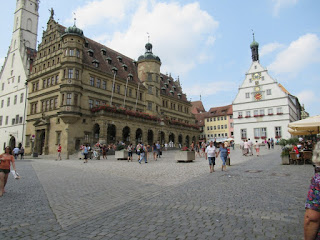I
traveled along the Rhein and other western parts of Germany by
train.
The ICE (Intercity-Express) is operated by Deutsche Bahn. I found the train ran at more than 300 km/h between Frankfurt am Main and Cologne. It is so fast.
The ICE train also provided us good WiFi services. I took a photo of the Rhein in the train and posted it in my FB during my travel from Bonn to Wurzburg. The connection was
good.
The
local trains have spaces for bicycles, which enables German people use their bicycles effectively.
Frankfurt hosts the European Central Bank. (see the 2nd photo from the top).
While preserving traditional towns, the city have increased new skyscrapers in the last two decades.
The EU is shaken after the Euro crisis and Brexit. Still, the EU’s flags and marks are everywhere Europe. I wondered the future of the region ( and the world).
While preserving traditional towns, the city have increased new skyscrapers in the last two decades.
The EU is shaken after the Euro crisis and Brexit. Still, the EU’s flags and marks are everywhere Europe. I wondered the future of the region ( and the world).
The
Marien Platz, (public square) in front of the city hall remains the atmosphere
of the middle age. I saw many tourists from China, Korea and other Asian
countries.
Bonn used to be the capital of Germany (West Germany). The capital was moved to Berlin in 1990 after the country's reunification.
The city had invited the U.N. institutions and other international organizations after the governmental offices left. The Bonn University has tens of thousands of students.
The city had invited the U.N. institutions and other international organizations after the governmental offices left. The Bonn University has tens of thousands of students.
Bonn
is famous as a hometown of Beethoven. I visited Beethoven house.
A
festival was held in the city square. People enjoyed meals
and drinks in front of the sculpture Beethoven..
It is impossible to talk about the tourism in Germany without referring to the Romantic Road and Rothenburg. It preserves the middle-age atmosphere.
I
joined a walking tour guided by a "night watcher."He gave me good explanations.
The town thrived in the middle age as a transportation hub; it was hit seriously by the black death (plague) in the 14th century; it was occupied and many people were killed in the Thirty Years’ War in the 17th century; it experienced no significant developments in more than 200 years after the war, which resulted in keeping old buildings. The town was focused on as a good sightseeing place in the 19th century.
The town thrived in the middle age as a transportation hub; it was hit seriously by the black death (plague) in the 14th century; it was occupied and many people were killed in the Thirty Years’ War in the 17th century; it experienced no significant developments in more than 200 years after the war, which resulted in keeping old buildings. The town was focused on as a good sightseeing place in the 19th century.
It
attracts millions of tourists today. The Market Place, which is surrounded by historical buildings, is so wonderful.
It is not only the old towns which attract visitors. A world-famous
Christmas-goods shop (Käthe Wohlfahrt) opened in 1977 near the Market Place. It was crowded with foreign tourists (even in August).
Germany is keen on environment and energy. I
saw many solar panels on the roofs everywhere. I also found power plants in many places. (See also the 3rd photo from the top)
This photo was taken from a train, so the .reflection of light appears, sorry.


















No comments:
Post a Comment